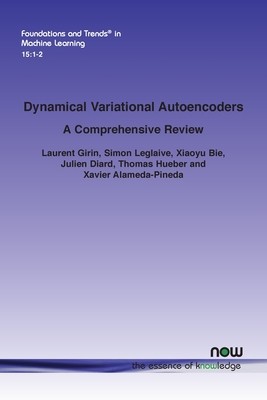
- We will send in 10–14 business days.
- Author: Laurent Girin
- Publisher: Now Publishers
- ISBN-10: 1680839128
- ISBN-13: 9781680839128
- Format: 15.6 x 23.4 x 1.1 cm, minkšti viršeliai
- Language: English
- SAVE -10% with code: EXTRA
Reviews
Description
Variational autoencoders (VAEs) are powerful deep generative models widely used to represent high-dimensional complex data through a low-dimensional latent space learned in an unsupervised manner. In this monograph the authors introduce and discuss a general class of models, called dynamical variational autoencoders (DVAEs), which extend VAEs to model temporal vector sequences. In doing so the authors provide: - a formal definition of the general class of DVAEs - a detailed and complete technical description of seven DVAE models - a rapid overview of other DVAE models presented in the recent literature - discussion of the recent developments in DVAEs in relation to the history and technical background of the classical models DVAEs are built on - a quantitative benchmark of the selected DVAE models - a discussion to put the DVAE class of models into perspective This monograph is a comprehensive review of the current state-of-the-art in DVAEs. It gives the reader an accessible summary of the technical aspects of the different DVAE models, their connections with classical models, their cross-connections, and their unification in the DVAE class in a concise, easy-to-read book. The authors have put considerable effort into unifying the terminology and notation used across the various models which all students, researchers and practitioners working in machine learning will find an invaluable resource.
EXTRA 10 % discount with code: EXTRA
The promotion ends in 23d.14:23:47
The discount code is valid when purchasing from 10 €. Discounts do not stack.
- Author: Laurent Girin
- Publisher: Now Publishers
- ISBN-10: 1680839128
- ISBN-13: 9781680839128
- Format: 15.6 x 23.4 x 1.1 cm, minkšti viršeliai
- Language: English English
Variational autoencoders (VAEs) are powerful deep generative models widely used to represent high-dimensional complex data through a low-dimensional latent space learned in an unsupervised manner. In this monograph the authors introduce and discuss a general class of models, called dynamical variational autoencoders (DVAEs), which extend VAEs to model temporal vector sequences. In doing so the authors provide: - a formal definition of the general class of DVAEs - a detailed and complete technical description of seven DVAE models - a rapid overview of other DVAE models presented in the recent literature - discussion of the recent developments in DVAEs in relation to the history and technical background of the classical models DVAEs are built on - a quantitative benchmark of the selected DVAE models - a discussion to put the DVAE class of models into perspective This monograph is a comprehensive review of the current state-of-the-art in DVAEs. It gives the reader an accessible summary of the technical aspects of the different DVAE models, their connections with classical models, their cross-connections, and their unification in the DVAE class in a concise, easy-to-read book. The authors have put considerable effort into unifying the terminology and notation used across the various models which all students, researchers and practitioners working in machine learning will find an invaluable resource.


Reviews